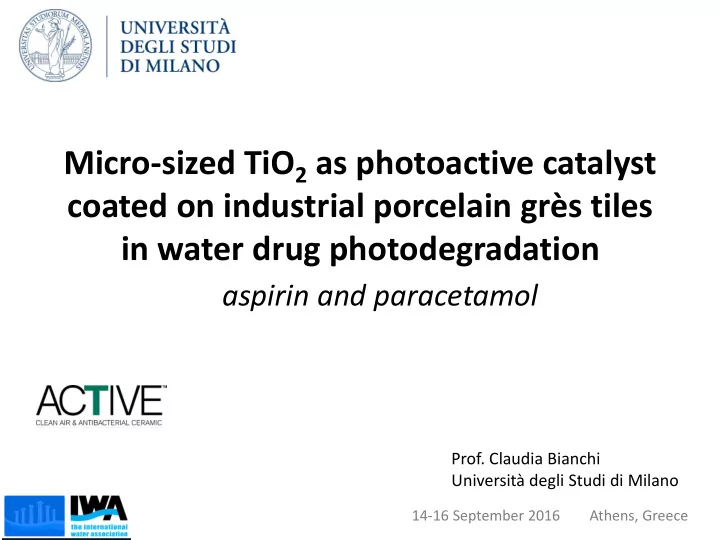

Micro-sized TiO 2 as photoactive catalyst coated on industrial porcelain grès tiles in water drug photodegradation aspirin and paracetamol Prof. Claudia Bianchi Università degli Studi di Milano 14-16 September 2016 Athens, Greece
European Union Legislation DIRECTIVE 2013/39/EU OF THE EUROPEAN PARLIAMENT AND OF THE COUNCIL of 12 August 2013 amending Directives 2000/60/EC and 2008/105/EC as regards priority substances in the field of water policy “… .the Commission shall, as far as possible within two years from 13 September 2013 develop a strategic approach to pollution of water by pharmaceutical substances” . COMMISSION DIRECTIVE (EU) 2015/1787 of 6 October 2015 amending Annexes II and III to Council Directive 98/83/EC on the quality of water intended for human consumption Programs to plan: “monitoring, parameters and frequencies, risk assessment, sampling method and sampling points regulation 14-16 September 2016 Athens, Greece
Photodegradation Emerging pollutants: test Emerging Aspirin ¶cetamol pollutants World Legislation Photocatalytic Wastewater Oxydation: AOP World Legislation Photoactive remediation TiO 2 catalyst porcelain grès tile Photoactive porcelain grès tiles: Photocatalytic TiO 2 Oxydation semiconductor 14-16 September 2016 Athens, Greece
Pharmaceutical compounds hydroxylic group (-OH) carboxylic acid group (-C(=O)-OH) acetoxy group (-O-C(=O)- CH 3 ) amide group (-NH -C(=O)-CH 3 ) Aspirin Paracetamol 14-16 September 2016 Athens, Greece
Background Traditional Physical Techniques TiO 2 Photocatalysis Transfer Organic Compounds from Water to another phase SECONDARY POLLUTION
Industrially produced photoactive porcelain gres
Photoactive porcelain gres ceramic tiles 1) Preparation 2) Photoactive modifies tiles Mixing and grinding Covering with a suitable micro- Milling of raw materials in water: TiO 2 based-ink via digital printing clay minerals, natural minerals (new) or spray deposition (old) (feldspar, silica) Forming by automated presses Treatment at high temperature: 680 ° C for 80 min P=7000 tons Brushing to remove unfixed Firing in a tunnel kiln at 1300 ° C for powder 60 min
Photodegradation tests Mineralization% Conversion% CONVERSION % : degradation of starting molecules into their by-products Aspirin and Paracetamol disappear over time MINERALIZATION % : degradation of all organic compounds into harmless inorganic compounds, as CO 2 and H 2 O. Aspirin, Paracetamol and their by-products are completely degraded over time 14-16 September 2016 Athens, Greece
Photodegradation results: comparison between spray and digital printing coatings Aspirin Paracetamol mixed together (1:1) Mineralization% Conversion% 100 100 100 Conversion (%) 80 80 80 Conversion (%) Conversion (%) 60 60 60 40 40 40 20 20 / 20 0 0 / 0 / 24 0 1 2 3 4 5 6 7 8 9 10 0 1 2 3 4 5 6 7 8 9 10 0 1 2 3 4 5 6 7 8 9 24 10 24 24 time (h) time (h) time (h) 80 80 80 Mineralization (%) Mineralization (%) 60 Mineralization (%) 60 60 40 40 40 20 20 20 / 0 / 24 0 0 1 2 3 4 5 6 7 8 9 10 0 / 0 1 2 3 4 5 6 7 8 9 10 0 1 2 3 4 5 6 7 8 9 10 24 24 time (h) time(h) time (h) Comparison between spray deposition ( u ) and ink-jet printing ( p ) tiles . Aspirin (red) and Paracetamol (black) as single molecule and then in mixture (1:1) 14-16 September 2016 Athens, Greece
Photodegradation Mechanisms Paracetamol Aromatic ring cleavage and further oxidation to CO 2 and H 2 0 Aspirin 14-16 September 2016 Athens, Greece
Photodegradation Mechanisms Paracetamol Keto-enolic tautomeric equilibrum between hydroquinone/benzoquinone [1] [1] A.G.Rincón , C.Pulgarin, N.Adler, P.Peringer, J. Photochemistry. and Photobiology A: Chem. 139 (2001) 233 – 241. Solvation phenomena by water molecules: Aspirin-5H 2 0 complex [2] Aspirin [2] M.Karthika, K.Senthilkumar, R.Kanakaraju, Computational and Theoretical Chemistry 966 (2011) 167 – 179. 14-16 September 2016 Athens, Greece
Use of tap water Milan Tap water composition (mg L -1 ) and chemico-phisycal characteristics [F - ] [Ca 2+ ] <0.50 86 [Cl - ] [Mg 2+ ] 34 19 2- ] [Na + ] [SO 4 58 18 - ] [K + ] [NO 3 30 2 - ] + ] [NO 2 <0.2 [NH 4 <0.1 - ] [Mn 2+ ] [HCO 3 222 <0.001 pH 7.7 Hardness 31 ° f 681 mScm -1 (a) Specific Conductance (a) at 20 ° C 14-16 September 2016 Athens, Greece
Photodegradation results: ink-jet printing . Tap water vs deionized water Fig.6 . Photocatalytic tests of paracetamol ( ) and aspirin ( ) as single molecule a) and mixed (b). Conversion % (full symbol), mineralization % (empty symbol) performed with digital printing tile. Tap water. 14-16 September 2016 Athens, Greece
CONCLUSIONS In this work the following key concepts were proposed: • Evaluation of industrially prepared porcelain grés tiles’ photoactivity for the water purification • Comparison between two different coating methods, both industrially feasible • Study of the degradation of mixture of drugs, closer to the environmental reality • Use of tap water, closer to the environmental reality • Lack of deactivation of the photocatalytic materials and possible immediate reuse of the tiles • Need a thorough study on the best reactor configuration for a real use of photocatalytic ceramics even in the water
Thank You for your kind attention
Recommend
More recommend